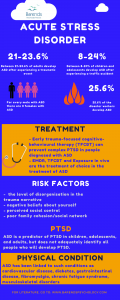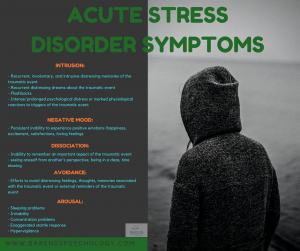What is acute stress disorder?
Acute stress disorder (ASD, also known as ‘shock’) is a mental condition that occurs at least three days after experiencing a traumatic event (such as traffic accidents, assaults, war, sexual violence and nature disasters) and disappears within a month after the traumatic event, or develops into posttraumatic stress disorder (PTSD). Approximately one in five adults develop acute stress disorder after a traumatic event [1] and between 8 and 24% of the children and adolescents after experiencing a traffic accident [2],[3]. Women are more likely to develop ASD compared to men: 23% versus 8% [4]. Despite the fact that this mental condition usually disappears within a month, diagnosing ASD is important, because
- (1) people with ASD suffer a lot from its symptoms,
- (2) 57% of the men and 92% of the women with ASD develop PTSD [4], and
- (3) because there are things people can do to reduce the impact acute stress disorder can have on people.
Understanding acute stress disorder also helps relatives and friends understand how ASD affects someone. Someone with ASD may experience concentration problems, irritability, difficulties remembering certain aspects of the traumatic event, and mood swings. Also, ASD is associated with physical health problems, particularly chronic pain [8]. By understanding what it means to have ASD, relatives and friends can offer their support to the person with ASD. A good support network and family cohesion reduce psychological distress and thus the ASD symptoms [5],[6].
If you would like a therapist to help you with these issues, you can book a no obligation consult with us here for free.
Go to:
- What causes ASD?
- Diagnosing ASD.
- ASD treatment.
- How to cope with ASD?
- Helping your partner with ASD.
- Take the ASD test.
- ASD facts.
- Online counseling for ASD.
- Take me to the homepage.
At Barends Psychology Practice, acute stress disorder treatment is being offered (also online). Go to contact us to schedule a first, free of charge session. (Depending on your health insurance, treatment may be reimbursed).
Acute stress disorder – signs and risk factors
Not only people who experience a traumatic event develop ASD, witnessing a traumatic event or learning that the traumatic event occurred to a close friend or relative can also cause someone to develop ASD. Also, being repeatedly exposed to the consequences of traumatic events (think of disaster workers) can trigger the development of ASD [7]. Some people are more at risk of developing ASD:
- women are more likely to develop ASD,
- people who’s narrative of the traumatic event is more disorganised,
- people who have more negative beliefs about themselves after the traumatic event,
- people working in fields where exposure to the consequences of a traumatic events are more likely: disaster workers, police men, fire fighters, et cetera.
- younger and unmarried people are more likely to develop ASD,
- for more risk factors, please go to: ASD facts.
If you would like a therapist to help you with these issues, you can book a no obligation consult with us here for free.
People with acute stress disorder may experience symptoms in five categories:
- Intrusion: recurrent distressing dreams or memories of the traumatic event, flashbacks, and prolonged psychological distress,
- Negative mood: being unable to experience positive emotions, such as happiness, excitement, and loving feelings,
- Dissociation: being unable to remember details of the traumatic event, feeling as if the time is slowing down,
- Avoidance: trying to avoid reminders/memories of the traumatic event,
- Arousal: feeling irritable, experiencing sleeping problems, concentration problems.
For the official diagnostic ASD criteria, click here.
Literature
- [1] Holeva, V., Tarrier, N., & Wells, A. (2001). Prevalence and predictors of acute stress disorder and PTSD following road traffic accidents: Thought control strategies and social support. Behavior Therapy, 32, 65-83.
- [2] Meiser-Stedman, R., Yule, W., Smith, P., Glucksman, E., & Dalgleish, T. (2005). Acute stress disorder and posttraumatic stress disorder in children and adolescents involved in assaults or motor vehicle accidents. American Journal of Psychiatry, 162, 1381-1383.
- [3] Forbes, D., Creamer, M., Phelps, A., Bryant, R., McFarlane, A., Devilly, G. J., … & Newton, S. (2007). Australian guidelines for the treatment of adults with acute stress disorder and post-traumatic stress disorder. Australian & New Zealand Journal of Psychiatry, 41, 637-648.
- [4] Bryant, R. A., & Harvey, A. G. (2003). Gender differences in the relationship between acute stress disorder and posttraumatic stress disorder following motor vehicle accidents. Australian & New Zealand Journal of Psychiatry, 37, 226-229.
- [5] Holeva, V., Tarrier, N., & Wells, A. (2001). Prevalence and predictors of acute stress disorder and PTSD following road traffic accidents: Thought control strategies and social support. Behavior Therapy, 32, 65-83.
- [6] Shaw, R. J., Deblois, T., Ikuta, L., Ginzburg, K., Fleisher, B., & Koopman, C. (2006). Acute stress disorder among parents of infants in the neonatal intensive care nursery. Psychosomatics, 47, 206-212.
- [7] Fullerton, C. S., Ursano, R. J., & Wang, L. (2004). Acute stress disorder, posttraumatic stress disorder, and depression in disaster or rescue workers. American Journal of Psychiatry, 161, 1370-1376.
- [8] Jenewein, J., Wittmann, L., Moergeli, H., Creutzig, J., & Schnyder, U. (2009). Mutual influence of posttraumatic stress disorder symptoms and chronic pain among injured accident survivors: a longitudinal study. Journal of traumatic stress, 22, 540-548.
If you would like a therapist to help you with these issues, you can book a no obligation consult with us here for free.


